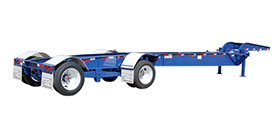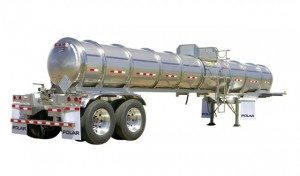Bulk liquid freight, such as petroleum products and chemicals, carry increased environmental risks and thus special care and equipment is needed when transporting these products. It’s of utmost importance for carriers to understand the necessary container specification and hazardous properties of the liquid being transported, the terrain and distance of the route, loading/unloading requirements and many other factors in order to specify and obtain the proper hauling equipment.
At the U.S. market for bulk liquid and chemical transportation continues to expand, companies must find ways to maximize the volume of their loads while minimizing costs and risk when shipping. To help organizations identify the right bulk liquid transportation equipment to fit specific needs, we’ve summarized some of the basic differences between chassis and trailer bulk liquid transportation equipment.
What are Tank Chassis used for in Bulk Liquid Transportation?
One of the most common bulk liquid transportation equipment are drop frame tank  chassis, which are typically longer chassis with a lower deck height making it ideal for transporting constantly shifting commodities like liquids via tank containers or Flexi-bags. Drop frame chassis are designed with a low center of gravity, which provides stability and reduces the chance of containers or their contents shifting during tight turns. In addition, the lower center of gravity works to reduce the likelihood of a turn-over accident. In the U.S., the only way to legally transport free standing tank containers with bulk liquids is by utilizing a tank container chassis.
chassis, which are typically longer chassis with a lower deck height making it ideal for transporting constantly shifting commodities like liquids via tank containers or Flexi-bags. Drop frame chassis are designed with a low center of gravity, which provides stability and reduces the chance of containers or their contents shifting during tight turns. In addition, the lower center of gravity works to reduce the likelihood of a turn-over accident. In the U.S., the only way to legally transport free standing tank containers with bulk liquids is by utilizing a tank container chassis.
Benefits of Tank Chassis for Bulk Liquid Transportation
- Ability to be fitted with special design features and accessories including lift-kits which elevate the front of the tank during loading and unloading to make emptying the tank container easier.
- Longer length works to legally scale most filled tanks.
- Available in tandem axle, tri-axle, and spread axle configurations
- Triaxle tank chassis can transport heavier loads typically with a general vehicle weight rating (GVWR) of 80,000 lbs. where permitted by applicable laws.
What are Tank Trailers used for in Bulk Liquid Transportation?
 Drop frame tank chassis are the frames which transport ISO tank containers or containers with flexibags holding bulk liquids. Tank trailers used for bulk liquid transportation are large, trailers typically constructed of steel or aluminium. The containers are attached to the trailers and used to transport liquids including gasoline, milk, wine, juice, etc. Bulk liquid transportation tank trailers average about 43’ in length and can vary on their load volume. Tank trailers are distinguishable by their cylindrical shaped tank.
Drop frame tank chassis are the frames which transport ISO tank containers or containers with flexibags holding bulk liquids. Tank trailers used for bulk liquid transportation are large, trailers typically constructed of steel or aluminium. The containers are attached to the trailers and used to transport liquids including gasoline, milk, wine, juice, etc. Bulk liquid transportation tank trailers average about 43’ in length and can vary on their load volume. Tank trailers are distinguishable by their cylindrical shaped tank.
Depending on the tank itself, it can carry multiple products in one load due to compartmentalization, which can be broken into up to 6 compartments for some models. Not only does the compartmentalization allow for an increased number of delivery options.
Different Types of Tank Trailers for Bulk Liquid Transportation
- DOT 407
- Maximum Allowable Working Pressure (MAWP) (up to 25-30 psi @ 300 degrees F) bulk liquid tank
- Average maximum capacity between 5,000 and 8,000 gallons
- Contents transported: mild acids, however, water, milk or combustible liquids
- DOT 412
- Pressure- 35 psi
- Average maximum capacity between 4,000 and 6,000 gallons
- Contents transported: Corrosives and high weight (gravity) liquids
- MC 307
- Maximum Allowable Working Pressure (MAWP) (up to 25-30 psi @ 300 degrees F) bulk liquid tank
- Average maximum capacity between 5,000 and 8,000 gallons
- Contents transported: mild acids, however, water, milk or combustible liquids
- MC 312
- Pressure- 35 psi
- Average maximum capacity between 4,000 and 6,000 gallons
- Contents transported: Corrosives and high weight (gravity) liquids
- MC 331
- Transports gases that are liquefied by pressure application only including propane, chlorine, and butane
- Pressure – 100 to 500 psi
- Average maximum capacity from 2,500 gallons for bobtail to 11,500 gallons for highway transport truck
Information Required to Determine the Optimal Bulk Liquid Transportation Equipment
- What is the liquid being transported?
- What are the liquid specific properties? Is it hazardous? Temperature sensitive? Require insulation?
- How many gallons need to be transported?
- What kinds of containers and equipment will you use to load and unload it?
- What size hose is needed for loading and unloading?
- Will the receiver’s facility require any specific equipment?
Bulk Liquid Transportation Equipment to Fit Your Needs
Do you have products, raw materials, or intermediaries for bulk liquid transportation? The right bulk liquid transportation equipment is important for maximizing payloads while transporting liquids. Let our experts help! We are happy to provide long-term leases for chemical and bulk liquid for bulk liquid transportation and storage. Our staff will work with you to help choose the right equipment to meet your specifications. Contact us today!

